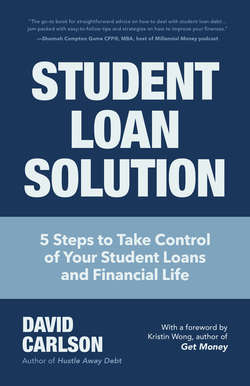Читать книгу Student Loan Solution - David Carlson - Страница 11
На сайте Литреса книга снята с продажи.
ОглавлениеBeing in student loan debt can make you do crazy things. Things you never thought possible—like moving back in with your mother.
At twenty-three, I dismantled my tidy, IKEA-trimmed apartment, sold some of my belongings, put the rest in boxes, and moved back into my childhood bedroom, with tape from my old Jonathan Taylor Thomas posters still stuck to the walls. My mother informed me my curfew would be eleven and dating was highly discouraged.
“Mom, I’m in my mid-twenties,” I said.
“Pfft,” she replied. “I don’t care if you’re thirty.”
She may have been strict, but my mom taught me the value of money at an early age. When I was eight, I stuffed dollar bills into my piggy bank to save up for toys and books. My mom would say, “every little bit counts,” and she was speaking from experience. When she was in her mid-twenties, my mom worked full-time in the cheese department at Kroger and part-time at Sunny’s, a convenience store down the street from our tiny, one-bedroom apartment. Somehow, on that meager income, my mom saved ten thousand dollars. She packed up her own one-bedroom apartment and moved us to a safer part of town. She wanted better for me: a better education, a better job, a better financial life.
Maybe that’s why I hated being in student debt so much. I was the first in our family to go to college, and, at twenty-three, I was earning twenty-five thousand dollars a year. It wasn’t much, but, for a family that spent most of the time struggling financially, this was kind of a big deal. There was so much I wanted to buy with that salary—a trip to Europe after college or a brand-new wardrobe—but I had a student loan to repay, and I couldn’t ignore it. Being in debt is like driving around with a weird, clunky car noise. You can try to pretend it’s not there, but you know better. Ignoring it will only make it worse.
Fueled by that frustration, I was determined to get out of debt. I didn’t just move back in with my mom; I took on part-time babysitting jobs. I had a side hustle selling used cowboy boots on eBay, like a less stylish Sophia Amoruso. After a year or so, I paid off my twelve-thousand-dollar student loan.
This may be the part where you scoff. After all, twelve thousand dollars is nothing compared to today’s average student loan borrower, who carries a debt of nearly forty thousand dollars. Back then, my student loan seemed insurmountable on my meager salary, so I can’t imagine being thrust into the workforce, smack-dab in the middle of a crisis. Hundreds of news articles and headlines dissect who is to blame for this student loan crisis. (I’ve written some of these articles, and the gist of it is: more students, less funding, and shady lenders and education-based businesses.) In truth, there are a number of entities to blame, which makes it easier for each of them to shirk responsibility and pass it onto the borrower, who dared try to afford to get a college education in the first place. The consequences reverberate through our economy nonetheless.
Headlines would have you believe Millennials are to blame for all our economic woes. We’re not buying homes, we’re not getting married—these headlines imply Millennials have a choice in the matter, as if we have $200,000 on hand for a down payment, but we’re postponing homeownership because we’re such darn procrastinators. The reality is Millennials are postponing homeownership for the same reason I’m postponing getting a star on the Hollywood Walk of Fame: it’s just a tad unrealistic.
We have little control over the economy, but we do have choices. We can choose to learn how the system works and become advocates for its repair by voting at the polls and voting with our dollars. We can also learn personal finance—the options we have for managing our own money and getting rid of our own debt.
For this reason, I’m grateful that this book and Carlson’s previous one, Hustle Away Debt, exist. I won’t pretend the solutions outlined here are as easy as moving back into your childhood bedroom. If you’re reading this, however, you probably already know how much of a struggle it is to be in debt. Like me, you’re probably also hell-bent on climbing out of it, which is why you’re reading this book in the first place.
On the pages that follow, Carlson explains your options for getting rid of your student debt—options many people don’t even know exist. You’ll learn how to organize your finances. How to pick a repayment strategy. You’ll even learn how to manage your own mental health as you’re going through the whole process, which will at times feel grueling, but is 100 percent worth it.
Amid all of this practical help, Carlson does the seemingly impossible. He gives us hope, something we need now more than ever. Wages have barely moved since the Great Recession, the income gap continues to widen, and student loan debt continues to soar. When it comes to money, hope doesn’t come easy. The good news is, you’re in the right place. Now more than ever, you need this book.
—Kristin Wong
Author, Get Money: Live the Life You Want, Not Just the Life You Can Afford
